Welcome to the all-in-one free SEO Sri Lanka guide by Alston Antony.

In this guide, I will share everything you need to know about SEO.
From beginning to advanced, I have something for everyone.
I will teach SEO basics, keyword research, on-page SEO, link building & more.
Let’s learn search engine optimization now.
SEO Basics
This SEO beginner tutorial assumes you do not know SEO.
The objective is to clearly understand search engines, SEO, and how it works.
This guide is based on the original basic SEO guide on this page.
SEO Basics Video in Sri Lanka
How does a search engine work?
This lesson’s purpose is to understand better what a search engine is, how it works, which search engines are the best, and how it adds new websites to its database.
Search engine definition
This is how I would define a search engine.
It’s a platform where you can search for something you’re interested in, and it will display relevant information it has stored in its database.
It sounds simple, doesn’t it? Like a directory.
However, web search engines are complicated due to their database being the Internet (World Wide Web), and they need to determine how to show the most accurate search results.
To understand the complexity, let’s look at some facts:
- There are over 1.1 billion websites on the Internet, so imagine the total number of web pages! (NetCraft, 2021)
- At least 5.55 billion pages are indexed in search engines (WorldWideWebSize, 2021).
- Google alone processes over 40,000 queries per second, or almost 3.5 billion per day. (InternetLiveStats, 2021)
Due to this, search engines may face the following problems:
- The Internet is full of web pages. Where do we find them all?
- Where do we store all the information from web pages in our database?
- How can we locate and retrieve data from our database for a search query?
- What is the best order to display the results?
- What are the best ways to present the results for a great user experience?
- How can I manage all users simultaneously?
To be effective, a search engine must answer all of the above questions.
Search engines: how do they work?
We will now take a quick look at how search engines work when you type a search query.
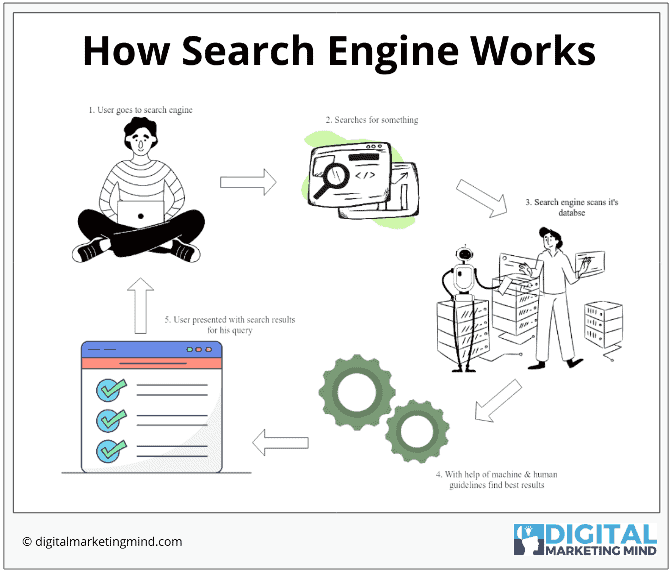
- A user visits a search engine
- The user searches for something
- Search engines scan their databases
- It finds the best search results using both machine and human guidance
- Results are presented to the user based on their search query
Market share of search engines
Let’s find out why all search engines are not the same.
First, we will take a look into the search engine market share.
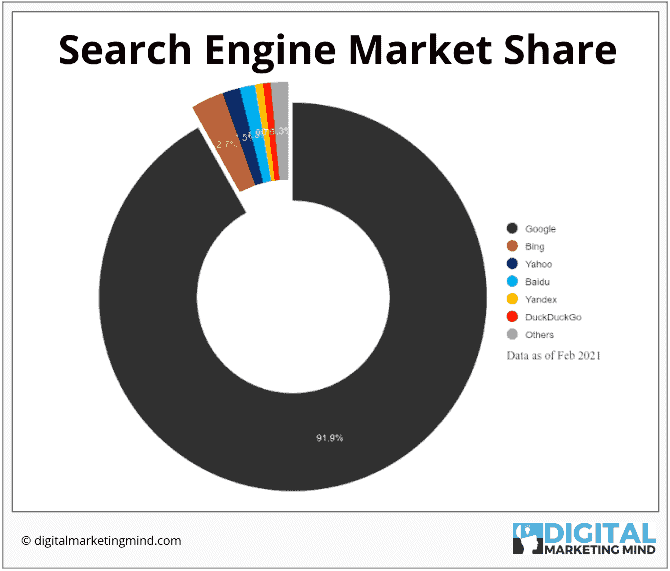
Market share data is as of February 2021 (StatCounter).
- Google: 91.86%
- Bing: 2.71%
- Yahoo: 1.46%
- Baidu: 1.13%
- Yandex: 0.087%
- DuckDuckGo: 0.66%
In light of the above percentages, Google is the king of search engines.
It has to do with the fact that they have provided the best solutions to all the problems search engines and users have faced.
This year, Google received 88.36 billion visits (Similarweb, 2019).
The Google index contains hundreds of billions of web pages. (Google, Unknown)
It makes sense to focus most of our SEO efforts on Google since it is the market leader.
As such, I will primarily focus on Google SEO optimization in this free SEO course.
It is also possible to optimize for Bing & Yahoo as a secondary option since they share databases and all Microsoft devices, and the operating system’s default search engine is Bing.
How does websites are added to search engines?
Here’s how search engines identify and add websites to their databases.
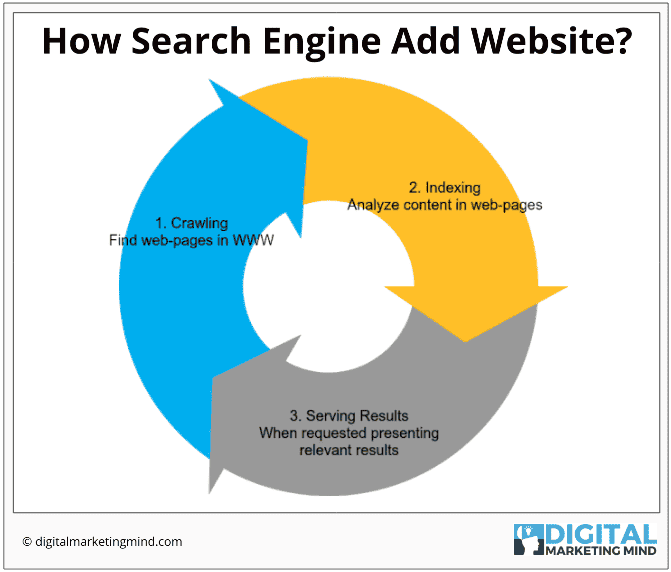
There are three main stages in the process:
Crawling
Automated apps continually scan the Web for all web pages (World Wide Web) in this process.
They are often referred to as search crawlers or web spiders.
Many search engines gather information about web pages by following links from other web pages that they already know.
Indexing
This stage involves the search engine visiting the pages it crawled previously.
Each page’s content, including text, images, video, PDF, and more, is analyzed to discover its topic and then categorized so they can be easily retrieved when needed.
They will store (cache) all the information in their database (Search index).
Serving search results
This occurs when someone searches for something on a search engine.
From its database (Search Index), search engines will show the most relevant and best set of results for each search.
Several factors determine which search results are “Best,” including searcher location, language, device, search engine algorithms (search rules & guidelines), user intent, SEO competition, and more.
How does SEO work?
We learned that search engines deliver the most relevant results for each search query from our previous lesson.
Search engines use ranking factors to select the best results for a search query.
According to these ranking factors, search engines use their own internal rules and guidelines to determine which results are the best for their users.
There are over 200 ranking factors in Google, but the company has never released them in full.
Definition of Search Engine Optimization
Let me now explain what Search Engine Optimization is.
SEO (search engine optimization) aims to rank your web pages at the top of organic (non-paid) search results in search engines by optimizing them according to ranking factors.
For example: You can use SEO in Sri Lanka to rank your website and web-page on top.
Referring to SEO can be done in several ways, and here are a few common ones:
- Website ranking
- Rankings in SERPs
- SEO promotion for websites
- Submission to search engines
- Positioning in search engines
- And more
Steps in the SEO process
There are several logical sub-processes involved in search engine optimization:
We will be able to stay focused and have a planned SEO process for our website.
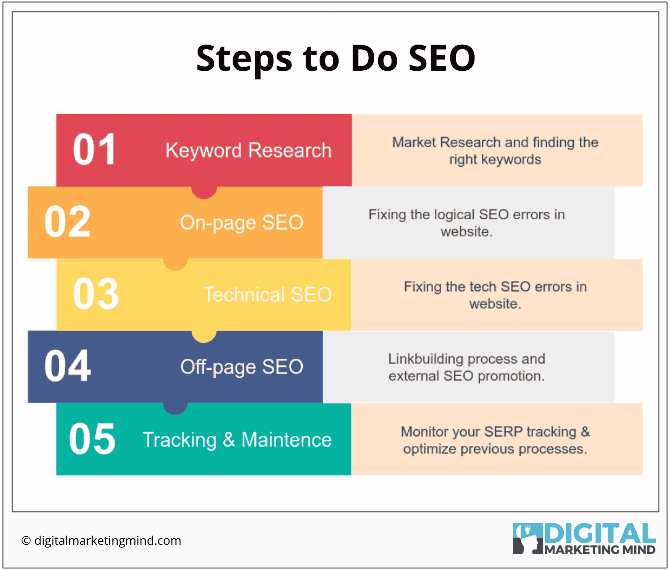
Here are the steps:
Researching keywords
You need to analyze your market to find relevant, right user intent and good search queries.
Optimization of the on-page SEO
You are optimizing the contextual & logical search engine ranking factors within your website.
Technical SEO optimization
You are optimizing the website’s technical ranking factors.
Off-Page SEO optimization
Optimizing ranking factors outside of your site is known as backlinking or link building.
Tracking and maintaining SERPs
We monitor, maintain, and optimize your SEO based on existing data, new industry updates and adjust the content/process according to these factors.
SEO Advantages and disadvantages
Among the many digital marketing methods available, let’s see why SEO is one of the best.
The pros and cons of search engine optimization will help you better understand why SEO is important.
Understanding the importance of SEO and whether it is the right digital marketing strategy will help you make a more informed decision.
We will now examine SEO’s advantages and disadvantages.
SEO benefits
There is a big opportunity
Over 3.5 billion searches are conducted every day on Google alone – that’s 40,000 searches per second. (InternetLiveStats, 2021)
This means that many users use search engines every day.
Search engines have great potential for reaching huge markets because demand keeps growing every day.
Attracts quality traffic
As opposed to other marketing techniques where you reach out to the customers.
You could, for instance, display ads on social media or print leaflets to promote your business.
People use search engines to find solutions or necessary information for their needs.
This means you are not going after customers or users, but they are coming to you.
In other words, if your search results are at the top of the page, users will find you and find you willing to assist them.
Targeted traffic for free
You will need to pay to display or for each click with most digital and local marketing methods.
Pay-per-click advertisements in search engines or monthly blog advertising subscriptions, for example.
However, search engine organic traffic is a channel where you do not have to pay for clicks or displays.
You receive free traffic that is also targeted to people searching for your solution or information for that reason.
Once ranked, less work is required
When you rank on the first page of search results for your targeted keywords.
Maintaining your top positions will become easier for you.
Accordingly, when a website ranks high in search engine results, search engines trust that website.
As a result, you will be able to maintain your high ranking for a more extended period of time than on a new website.
When ranked, there are more opportunities
The higher your website ranks in search results, the higher its SEO power, meaning search engines trust it.
Once you rank for these keywords, you can start ranking for lower-to medium-competition-level keywords with relatively little to no SEO effort.
SEO is more trustworthy than PPC
Pay-per-click advertising is also known as PPC.
Search engines offer you the option to pay per click on the search results page for target search queries to advertise your website.
On the search results page, these ads appear at the top, bottom, and right sides.
PPC management and optimization in search engines are known as search engine marketing.
Because of this, you might think it is possible to get all organic traffic by investing a lot in PPC campaigns.
Indeed, advertisements are sometimes clicked on, but only 15% of people do this.
The human instinct to avoid advertisements and ad-blockers are common reasons for this.
Therefore, SEO can increase your website’s visibility and credibility in search engine results.
Increases brand awareness
You’re demonstrating your status as one of the industry’s leading players by ranking among the top positions.
An untrustworthy site won’t be ranked high by search engines.
Making your brand more visible will result in a lot of indirect marketing benefits.
There are many ways that others can link to your website from their articles; potential stakeholders can get in touch with you, and so on.
Tracking growth is possible
Marketing strategies are difficult to measure most of the time.
SEO, on the other hand, is one of the simplest ways to measure your progress.
To track your SEO progress, you can use a variety of tools, including:
You can track your ranking growth with the SERP tracker.
Google provides free analytics and search consoles to monitor your site’s SEO data.
Using third-party free or paid software, you can also track more SEO data, such as backlinks, keywords, on-page SEO optimization, and technical SEO.
Overall, it is easy to track SEO, and you can monitor its growth too.
SEO disadvantages
Let’s now take a look at some significant cons of SEO.
Results Are Not Instantaneous
The importance of understanding this factor cannot be overstated.
Remember that dozens or hundreds of competitors have already ranked for a particular search query, possibly have been doing search engine optimization or building trust for their websites for years.
There’s no such thing as starting SEO today and getting ranked tomorrow or in a couple of days.
Maintaining your top rankings requires consistent SEO efforts.
Competition in SEO
The practice of SEO can generate significant profit when used correctly and effectively, which is well known to many marketers.
Due to this, SEO competition has never been higher, and even seasoned SEO professionals admit it’s challenging to rank on the first page.
Ranking for keywords has become increasingly complex, even if you have done everything right.
You must therefore continue to work smartly on SEO.
Instead of targeting highly competitive keywords within your industry, you could target low-competition keywords.
Updates to search penalties and algorithms
Using bad SEO practices or abusing SEO may result in these actions being taken by search engines.
You can be penalized by search engines by having your site removed from its index or by having its ranking dropped from the top.
Since SEO can either have a positive or negative effect, you must be cautious when making decisions.
Usually, these negative effects are hard to recover from.
There is No Secret Technique
It isn’t difficult to do SEO when you understand what you’re doing.
However, it would be best to keep in mind that SEO success will require hard work, creativity, time, and money.
This is especially true if you work in a highly competitive field.
80% of users never go past the first page
Your goal should always be to rank in the top 3 positions of search engine rankings since this is where most of your users go.
Search engine results at the end of the page receive very little traffic, and anything past the second page rarely attracts visitors.
If your website does not appear on the first page of search results, there will be no organic traffic to your website. Having a high ranking is essential for receiving organic traffic.
SEM vs SEO: what’s the difference?
We discussed the importance of SEO in previous lessons, as well as its advantages and disadvantages.
This lesson aims to explain what Search Engine Optimization (SEO) and Search Engine Marketing (SEM) are.
SEM vs SEO
Let’s take a closer look at SEO, SEM, and how to decide which is right for you.
SEO and SEM are not the same.
It is a process of improving your site’s ranking within organic or unpaid search results.
The search engine marketing (SEM) strategy is to optimize paid advertising on search engines, also called PPC advertising, displaying ads on search engine result pages (SERPs).
Search engines such as Bing and Google offer to advertise to their users.
Advantages of SEO over SEM
Unlike search traffic, which is free, SEM requires you to pay for every click you receive, even if they leave your website straight after clicking or if they do not interact with your website at all.
Ad blockers often block advertisements on search engines and other websites. According to Statista (2021), 27% of Americans block ads using adblocking technology.
The click-through rate of ads is less than that of organic listings, according to reports. The reason could be anything from psychology to technology.
Although SEO is slower than SEM, it has a higher chance to generate huge profits and ROI in the long run.
Advantages of using SEM over SEO
In SEO, you cannot expect results within a short period of time, but with SEM, you can. Once you start your AD campaign, all your target audience will see your ad in search results as soon as it’s published.
The cost of PPC ads will vary based on the industry and how many advertisers are bidding for the keyword at the same time. A click can cost anywhere from 0.10$ to 500$, so if you have enough budget, you can target as many keywords as you want.
You don’t need to worry about SEO: SEM is not about SEO optimization, and you don’t need to optimize your website, build backlinks, or boost SEO power. Instead, it’s all about buying ads and managing them efficiently. Therefore, if you choose SEM, you won’t have to worry about SEO factors.
Due to SEM’s fast results, you can easily see if your chosen keyword(s) or niche are profitable. If any changes need to be made, you can adjust accordingly and restart.
SEM can be profitable in the short term because of its flexibility and speed.
What to choose? SEO or SEM
SEO and SEM are both excellent digital marketing strategies.
We have seen that both strategies have pros and cons in this lesson. Consequently, there is no right or wrong strategy; instead, you must choose the one that suits your needs best.
There is no need to choose since you can do both simultaneously and get faster results with SEM (since SEO takes time) while getting a higher ROI with SEO (since you don’t have to pay for every click).
From that, it should be clear what the differences between SEO and SEM are.
Understanding Search Engine Results Pages (SERPS) for Beginners
This lesson will teach you what a search engine result page is, its main components, and how to use it effectively.
What is the SERP?
The search engine results page refers to the results you get back once you click on the search button in the search engine.
Let’s take a look at all the elements you’ll find on SERP pages.
In this guide, I will use Google to illustrate SERP page elements because of its popularity, as we saw in our previous lesson.
SERP Elements
When typing something in Google’s search bar, the auto-suggest feature will suggest related keywords based on its database and other users’ previous searches.
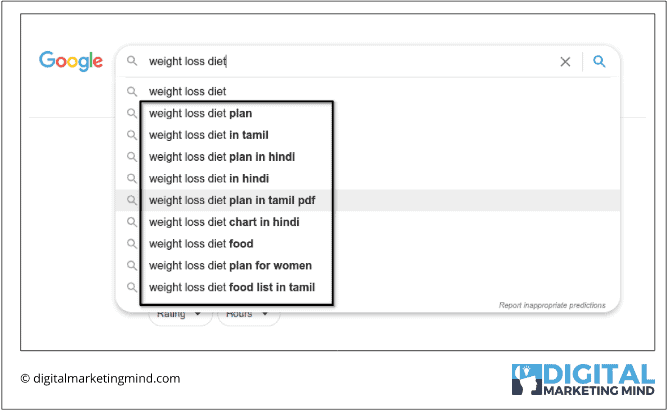
Different tabs on the search results page organize the content logically. They include:

- All – This is the default which shows all the results
- Images – Displaying images.
- News – Displays news results.
- Maps – Displays location and navigational information.
- Books – Displays books and educational results.
- Shopping – Displays products and results.
- Videos – Displays video results.
The “Tools” filter lets you sort web results based on specific time frames, such as the past hour, the past day, the past week, the past month, the past year and more.
In the “Setting” filter, you can select different options to customize the search results page, including the number of results you want to see per page, the language you want, and viewing history.

Whenever you see a number below a search bar, it’s the search index count for that specific search query.
The number of relevant results is shown here.

The Google Adwords listings are advertisements that you pay for each click you receive. It will appear on the SERP pages in various positions, such as the top, bottom, and sidebar.

These are local results based on your geographical location.
Based on the “Google My Business” listings, you will typically see businesses and services in your area.
In my free local SEO course, I will go into more detail about this.
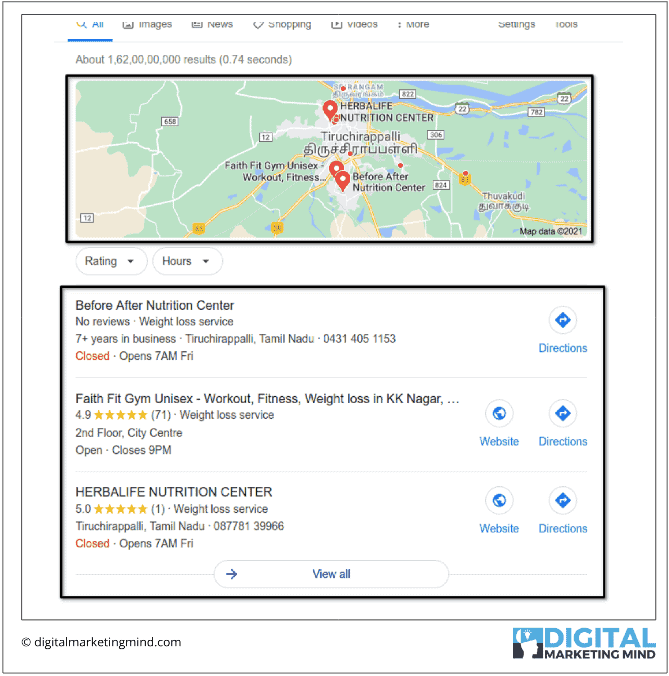
The People Also Ask section displays relevant questions related to the industry you searched for.
When you click on the question, the source and answer will be revealed.
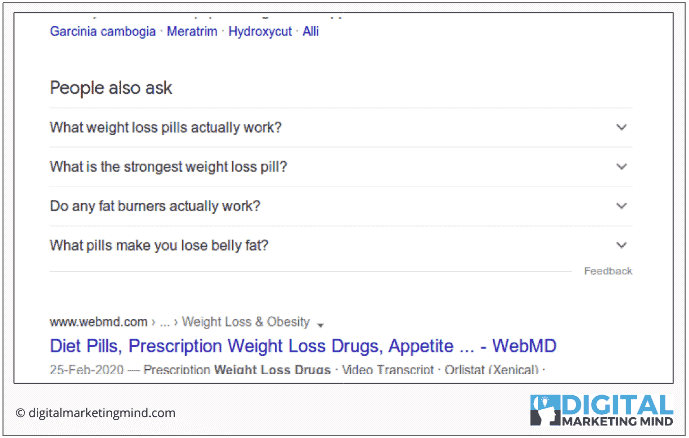
The following are Google shopping results & ads from PPC. Typically, it appears at the top, sidebar and footer of search results for targeted commercial keywords.

When it makes sense, Featured Snippets display as a single answer at the top of organic search results and are known as zero search place snippets.
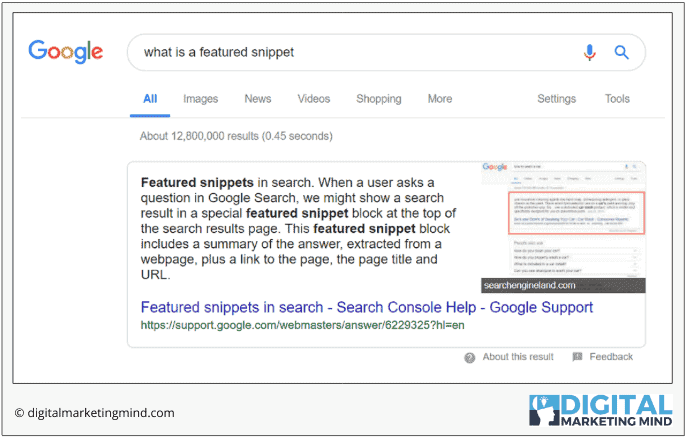
You will see video results snippets from video sites (mainly YouTube, Dailymotion, and Vimeo) relevant to your search query.
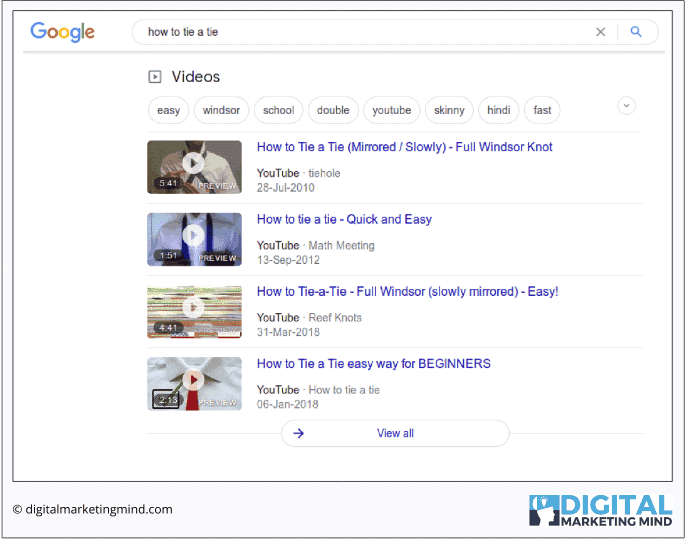
The images results shown by Google are based on what is indexed on the websites Google indexes.
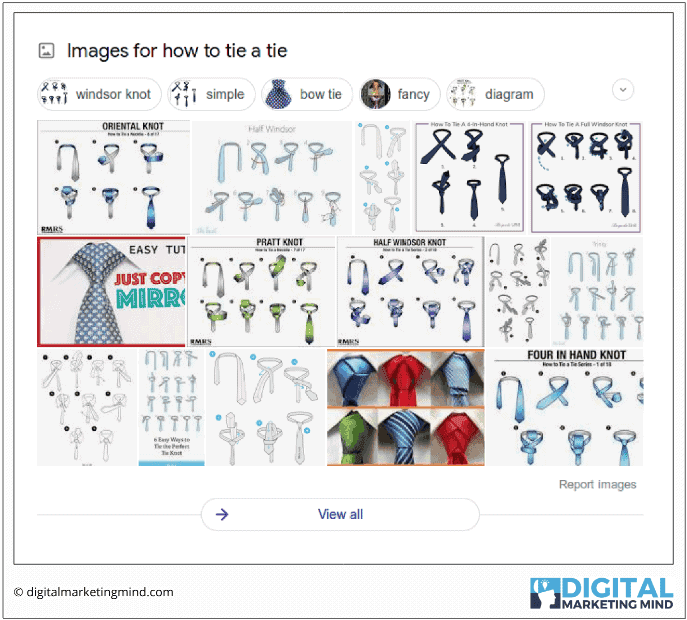
The social content snippet displays social messages related to your search query from popular networks such as Twitter.

Related searches provide related searches based on search engine databases, artificial intelligence, and previous searchers’ histories.
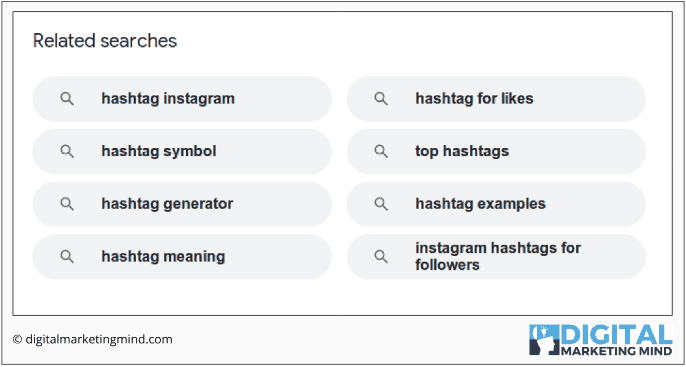
You can navigate search results by using the page navigation.

Different Types of SEO
Having learned about search engine optimization previously, we know what it is.
All SEO types follow the same process, but workflow and metrics will differ depending on specific requirements.
Here are some types of SEO that you can do.
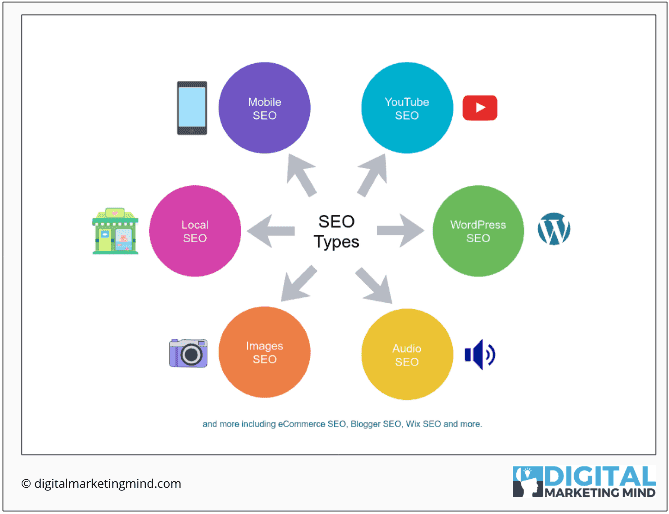
International SEO
This is the most common method of ranking pages in search results pages that target the global audience.
Local SEO
By targeting a specific country, state, city, or neighbourhood, you aim to boost your ranking in a specific geographic area.
Local SEO can be used for:
- Website for your business
- Business listings on Google and Bing
- YouTube video for your business
- and more.
This type of SEO is ideal for small businesses selling products or offering services in a specific geographic area.
Here are some facts (Hubspot, Unkown) about local SEO that show its importance to business owners:
- 72% of buyers searched for local stores within five miles and visited nearby stores.
- Approximately 97% of people look up local companies online.
- Mobile searches for local businesses result in 88% of calls or visits within 24 hours.
- In 78% of location-based mobile searches, offline purchases are made.
- In the last two years, searches for “near me” and “close by” have increased by more than 900%. For example: “best digital marketing agency near me“
SEO for YouTube
Video optimization aims to make your videos frequently appear in recommended and related videos on YouTube and rank higher on search results.
Here are some reasons to optimize YouTube (YouTube Press, Unknown):
- More than 2 billion people use YouTube.
- Youtube is available in 80 languages and localized in more than 100 countries.
- Every day, 1 billion hours of video are viewed.
- More than $2 billion has been paid to YouTube partners for monetizing their videos over the past five years.
SEO for Video
Optimizing your YouTube videos to rank higher in search engine results is the process of making them more visible to search engines.
These are a few reasons for optimizing your videos for search engines:
- Google owns YouTube so that YouTube videos will appear prominently in search results.
- In contrast to new websites, YouTube videos are hosted on YouTube, a website that is already trusted, so getting ranked there will be faster than on new sites.
- Videos are more captivating than texts, and people watch videos for more extended periods of time than they read.
SEO for images
The purpose of image SEO is to improve the rankings of your website’s images in image search results or image snippets in the search engine result pages.
You should optimize your images for search engines for the following reasons:
- An image snippet appears in 33% of all searches in search engines. (MozCast, 2021)
- Images can be searched using dedicated sections on search engines.
- People often use Google Images when they expect only to find images.
Mobile SEO
From a desktop or mobile device, search engines return different SERP results for the same query.
As mobile users increase, it becomes one of the most important factors of SEO.
To rank well on mobile search results, search engines have specific guidelines for mobile-optimized websites.
The definition of Mobile SEO is:
An approach to SEO optimization that focuses on mobile user experience to achieve higher rankings in mobile search engine results pages (SERPs).
The following are some of the significant benefits of Mobile SEO:
- Mobile phones account for 52.2% of all worldwide website traffic. (Statista, 2019)
- Mobile searches outnumber desktop searches. (ThinkWithGoogle, 2016)
- At least 87% of smartphone users use search engines daily. (Yahoo, Unknown)
- More than 40% of mobile website visitors will abandon your site if it takes more than 3 seconds to load. (ThinkWithGoogle, 2016)
SEO for eCommerce
Online commerce refers to the sale of products or services through the Internet.
Among the significant examples are Amazon, eBay, and AliExpress.
SEO for eCommerce store websites differs from SEO for regular websites and blogs.
Therefore, my definition of eCommerce SEO is
SEO is the process of optimizing your store website and product pages, so they appear higher in search engine results pages (SERPs) for commercial intent searches.
To help you understand the importance of eCommerce SEO, here are some facts:
- It’s estimated that 95% of all purchases will be made through eCommerce by 2040. (Nasdaq, 2017)
- 44% of people begin their online shopping with a Google search. (nChannel, 2015)
SEO for WordPress
WordPress is a free content management system (CMS) that enables you to create and manage a website or blog without any knowledge of HTML.
Dynamic websites can be created easily and quickly in this way.
WordPress CMS powers around 40% of websites on the Internet (W3Techs, 2021). At least 500 new WordPress sites are created every day.
SEOExpert.lk even uses WordPress.
A free WordPress plugin, wooCommerce, can convert your website into an online store in addition to being popular CMS for sites and blogs.
In other words, WordPress SEO entails optimizing your WordPress blog for search engine results to achieve higher SERP rankings.
Other Types of SEO
There are more types, including:
- PlayStore SEO is the process of optimizing an app to appear at the top of search results within the PlayStore.
- Blogger SEO refers to the optimization of Google Blogger blogs for search engines.
- Wix SEO refers to the process of optimizing Wix CMS blogs for search engine optimization.
- Voice SEO is the process of enhancing your audio content for voice searches using SEO techniques.
- In news SEO, you optimize your articles to index them quickly and appear higher in the search engine’s news section.
Google Algorithm Updates & Penalties
We will focus mainly on Google for this course since it is the market leader I mentioned in our previous lesson.
Google is the subject of this chapter.
We will cover what Google algorithm updates, why they occur, the types of updates, and their effects in this chapter.
How does Google Algorithm Update work?
Google is known for showing relevant search results based on a user’s search query.
Google uses several algorithms, ranking factors, and guidelines to provide more accurate results.
Over time, Google will add, update, and remove its rules and guidelines.
This is called “algorithm updates.”
What are the latest Google algorithm updates?
Google constantly releases algorithm updates so that the latest one will change regularly.
Google doesn’t announce every update. However, if an update has a significant impact on search engine rankings, they do announce it.
If they announce it, it will be published on their webmaster blog or official Twitter account.
As part of monitoring algorithm updates, you can also use third-party tools like MozCast, Semrush & more, where you will find out about updates before Google announces them.
You can also follow a variety of SEO authority blogs and news channels to keep up with SEO updates, such as:
- https://moz.com/google-algorithm-change
- https://www.seroundtable.com/category/google-updates
- https://www.searchenginejournal.com/google-algorithm-history/
- https://developers.google.com/search/blog
How have Google’s algorithms changed over time?
Let’s review some of the most significant search algorithm updates in the past. As I mentioned in the beginning, there are many changes, and some are not even announced.
If Google does not announce an update, but we find it a major one, we call them core updates.
You don’t have to worry if you don’t understand some of the terms I will mention because we will go over them in detail in our free SEO technical and on-page optimization course.
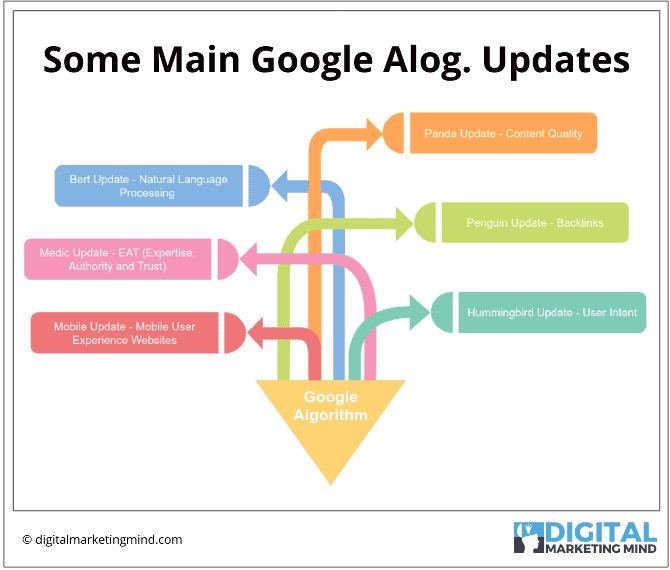
Panda update
We checked the content quality of web pages.
It checks for duplicate content, plagiarism (copied content), thin content (empty pages) and spam.
Penguin update
The goal was to identify low-quality or spammy backlinks.
It checks for spammy linked websites, buying backlinks, public blog networks, irrelevant links, over-optimized anchor texts, etc.
Hummingbird update
The focus was on logical content analysis and optimization.
It identifies keyword stuffing and low-quality content, analyzes user intent, and analyzes search queries.
Mobile update
A significant focus was to ensure that websites were mobile-friendly due to the increase in mobile search users.
Besides checking mobile responsiveness, it also looks at mobile user experience.
Today, having a mobile-friendly website is no longer an option; it requires Google search results.
RankBrian update
The focus was on understanding the user’s intent and the user experience.
As a result of machine learning advancements, they attempt to ascertain a search query’s intent and deliver the most relevant search results.
Medic update
Our focus was on medical, legal, and educational websites that provide life-changing information.
The main reason behind this is that so many spam or shady websites offer multiple solutions without doing a proper background check, authenticating their reliability & expert knowledge.
As a result, Google has introduced this search update to make the information ethical and trustworthy.
The E-A-T metric, which stands for expertise, authority, and trust, is used to validate the credibility of medical, legal, and educational websites.
Bert update
The aim was to optimize content and establish authority.
Natural language processing is used to analyze the content and improve the accuracy of related search results by understanding search queries better, identifying entities and relationships between entities.
Google Search Penalties – What are they?
SEO requires you to understand this action.
Google will take one of two steps, based on its algorithm & guidelines when a website fails to meet quality standards:
Automatic penalty
This can negatively affect your website’s ranking in SERPs when the search engine finds that your site is not following its rules without any human involvement.
Your site’s ranking will be lowered as a result, and to recover your ranking, you must determine what you did wrong, fix it, and continue to optimize it.
Eventually, the penalty will be reversed by the search engine.
Manual penalty
A search engine webspam team member visits your website and examines whether you have abused SEO in any way. If they find any evidence, they will apply a manual penalty.
You cannot recover from this since it is the worst-case scenario where you need to fix everything listed and request a re-evaluation from a search engine.
The process of getting back on track is possible, but it will take a lot of effort and time when compared to the automatic penalty.
Your website can be negatively or positively affected by your SEO efforts, so keep that in mind.
Despite being optimized for the current SEO algorithms, your website is still vulnerable to future algorithms, even if it’s optimized for the current ones.
Setting realistic expectations for SEO
To set SEO expectations, it is important to understand that SEO is a long-term process.
This lesson will discuss what can be done and what cannot be done in SEO.
This type of lesson is usually ignored in SEO basics.
However, it is essential to understand achievable SEO goals, expectations, and myths to succeed on the Web.
Importance of understanding SEO realities?
Take a look at why understanding SEO reality is essential:
For Your-Self: Set your own realistic SEO goals as you are learning SEO for yourself, as this will keep you on track, motivate you, and help you plan your resources.
When hiring: Sometimes, to gain your order, someone may attempt to make false promises, but as long as you have a solid grasp on SEO, you can tell whether or not the promise has any merit.
When Selling: It is important to educate your clients on achievable SEO goals so that you do not unknowingly mislead them when selling SEO services.
Realities of SEO
We’ll now discuss some of the significant SEO realities you should know as an SEO marketer.
Ranking in top SERP positions isn’t easy
Most of the time, it’s misunderstood or misused in the SEO industry.
It takes a lot of time, effort, and resources to rank on the SERPs.
Hundreds of websites have been optimizing their web pages for SEO for years, and search engines trust them to keep them in the top SERP positions when you create a new website or optimize a webpage for the first time.
Therefore, you must perform better SEO than all of them to convince search engines to rank your website higher than theirs, a process that will not be easy.
Ranking times vary based on factors such as keyword competition, industry website SEO, your site’s SEO status, and others.
Realistic Time Frame for Ranking
According to my experience, here is an estimate of how long it takes to rank when you do SEO effectively:
Low Competition Search Queries
Usually, you can rank in the top search engine spots within 1-3 months if your SEO competition is low and your competitors do not do SEO at all or do a poor job.
Medium Competition Queries
You might achieve higher rankings in 3-6 months if your target search queries have moderate SEO competition where some competitors perform good SEO, but most do not.
Hard Competition Queries
Search engine ranking can be expected within 6-12 months if your targeted search query has high SEO competition and most of your competitors are doing good SEO.
Highest Difficulty Search Queries
If your competitors have been doing excellent SEO for years, you should expect to rank in no less than 12 months.
How to decide time ranking
It is important to keep in mind that these are not fixed and can be affected by a number of factors.
In addition, you may want to invest more resources like time and money to speed up the ranking.
However, keep in mind that the growth needs to be maintained; otherwise, it will appear unnatural, causing your website to be negatively evaluated by search engines.
SEO is not a one-time activity
There is no one-time SEO process.
SEO consists of optimizing both the on-site factors of the website & the external factors that affect its ranking.
To maintain your top ranking, you need to constantly perform SEO so that your competitors do not overtake you.
People assume it’s a one-time process for a variety of reasons:
- When there is little SEO competition, you can rank with just on-page optimization.
- Then you might be ranked for low to medium competition search queries with little or no SEO effort if your website is extremely SEO-powered.
To achieve and maintain high SERP rankings, you must therefore realize that SEO requires continuous effort.
On-Page SEO doesn’t work for competitive keywords
SEO is a four-step process, as we discussed in our search engine optimization chapter.
It includes Keyword research, On-page SEO optimization, Off-page SEO optimization, as well as SERP maintenance.
When your target market isn’t competitive, you can rely on good keyword research and on-page SEO.
Search engine optimization will generally require hard work in four major areas to achieve better rankings.
SEO can be expensive
It is possible to do SEO optimization for free, but there are many limitations.
Here are some reasons why SEO can cost you:
Time
In some cases, paid tools can provide faster and more accurate keyword research, whereas free tools will only provide limited data and require more manual work.
Complete Metrics
When it comes to keyword research or off-page SEO, relying only on free tools will not provide complete data, and sometimes it’s not possible.
High Competition
Popular industries tend to have more difficult SEO competition since all your competitors know that top rankings are well worth the investment of both time and money.
This means you won’t be able to compete or beat them by using free resources in a short timeframe or without investing many resources.
Data inaccuracy will result in failure
If you optimize an SEO campaign using incomplete or inaccurate data, you can make many mistakes.
When you choose the wrong target keywords, the whole SEO process will be useless.
Despite this, free SEO tools might mislead you with a limited database or feature set.
Outreach can be expensive
Since your SEO competitors will also outreach a lot, you need to work smartly on your outreach.
When you do link building, outreach, and partnerships, there will always be some expenses.
You can sponsor an event, pay for press releases, and opt for outreach software, for example.
As a result, it involves some kind of direct or indirect cost to reach out.
Traffic doesn’t mean profits
It’s more important to focus on search intent and targeted traffic in SEO than search volume.
Additionally, I will address this topic in my free keyword research course in detail as well.
No matter how high the search volume is, no-targeted traffic will lead to fewer conversions than targeted traffic.
Instead of focusing on search volume, focus on intent and understanding your target audience’s mindset.
SEO doesn’t come without risk
Because search engines cannot evaluate every site manually, they use algorithms, AI, and cutting-edge technology.
In our lesson on search algorithms & penalties, we learned that it identifies websites that misuse SEO or use spammy practices and negatively affects their ranking on search results.
It’s important to remember that any process you do for SEO has a risk, and if done incorrectly, it can negatively impact your website.
What’s the difference between White Hat, Black Hat, and Gray Hat SEO?
There are no fixed methods for ranking in SEO.
SEO strategies can range from ethical tactics to unethical ones.
Therefore, SEO strategies can be divided into three categories.
The three types of SEO are white hat, black hat, and grey hat.
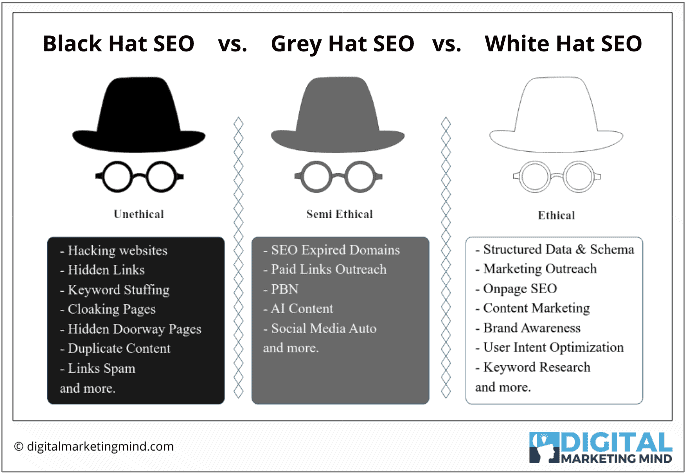
Black Hat SEO
In black hat SEO, unethical methods are used to achieve better rankings in search engine results pages.
Most of the updates in Google’s search algorithm’s goal is to prevent users from doing this. It is against the search engine’s guidelines.
It still works in the short term, but it is likely to fail in the long run.
Among the techniques are:
- Link-hacking on websites
- Hidden link injection for links
- Stuffing keywords
- Clanking pages to show users & search engines different pages
- Hidden and doorway pages
- Duplicate and copy other people’s content
- Spam comments on blogs
- and more
Black Hat SEO is commonly used in a few different industries, including casinos, the adult industry, sneakers, and loans, where even ranking for a short time can be profitable.
Even though not every black hat SEO method is illegal, some of them could seriously harm your reputation and your business.
White Hat SEO
White hat SEO refers to the use of ethical methods to improve ranking on SERPs.
Google encourages you to focus on user experience in this strategy.
White hat SEO methods include:
- Schema and structured data optimization
- Relevant marketing outreach for SEO
- On-page SEO optimization
- Copywriting and content optimization for SEO
- Brand awareness building
- Keyword research based on user intent
- and more
This is one of the safest SEO approaches, which also protects your website over the long run.
Grey Hat SEO
Grey hat SEO involves using semi-ethical tactics to increase search engine ranking.
It’s sort of a hybrid between Black Hat SEO and White Hat SEO.
Grey hat SEO is defined differently by different people.
Here are some examples of Grey Hat SEO techniques:
- Acquiring high-power expired domains
- Paid links outreach
- Automated creation of backlinks
Although search engines have not yet announced these grey hat strategies as bad practices, we know that they are not entirely ethical either.
How to decide SEO method?
SEO strategies will continue to evolve along with the classification of SEO types.
Grey hat SEO methods can quickly become black hat methods tomorrow.
Therefore, don’t overthink classification.
For a safe and effective SEO strategy that can protect your website or web property in the future from algorithm changes, it is advisable to focus on an ethical strategy.
SEO Quiz for Beginners – Test Your SEO Skills
This quiz will test your knowledge of the SEO basics you have gained from this free course.
You can use it to check what you have learned.
If you get “PASS”, you have a good SEO foundation and are ready for the keyword research course.
You may need to retake the SEO basics course if you receive “FAIL”.
SEO Quiz for Beginners – Test Your SEO BasicsConclusion to Beginner SEO
Congratulations on completing this free SEO basics course for Sri Lanka.
However, you are just starting your search engine optimization journey.
Next, we will move on to the “Keyword Research in Sri Lanka” SEO course.
Keyword Research
In search engine optimization, keyword research is important to determine what words or phrases are most commonly searched in search engines and to find out how much traffic these can bring to your website.
A bad keyword research strategy can lead to a lot wasted time and money in future, so it’ s important to do your keyword analysis properly.
In this guide, we’ll go through the entire keyword research process step by step, however, before we do so, let’s cover some basics.
Watch full keyword research in Sri Lanka video
Keyword research basics in Sri Lanka video
What is keyword?
In the SEO industry, the keyword stands for a unique word or phrase that people type into search engines in order to get the content they are searching for.
What’s keywords for searcher
A keyword or key phrase is a word or set of words that you use to search for information on the web.
Keywords can be a single word, phrase, or sentence fragment.
They can also be complete sentences.
What’s keywords for website’s owner
If you want your website to rank high in search engines, then it is important to choose the right keywords for your products, blog posts, articles, and pages.
So that you can get traffic from search engines.
What’s keywords for search engine
When you’re looking for something on the web, search engines such as Google, Bing, and Yandex use undefined to understand the content of a web page and rank it accordingly based on SEO factors.
A search engine uses keywords to understand the content of a web page and rank it accordingly based on SEO factors.
Keyword types
Now that we know what keywords are, let’s see what types of keywords are there.
Most of the time definitions for these keyword types will vary from person to person.
SEO Keywords: Keywords for SERP ranking
These keywords are created from SEO lingo, and they represent organic or SERP keyword.
Seed keyword
A seed keyword is a word or phrase that is used as a first step in a business.
Primary keyword
You aim to rank high in search engine results by using a term that is popular or relevant to your target audience.
Secondary (Related) keyword
A secondary keyword is a related keyword to your primary keyword.
These keywords expand the web page’s reach in SERPs and add more content for those using them.
LSI keyword
First of all, LSI keywords do not exist; it’s an incorrect term that we use.
Latent Semantic Indexing is known as LSI.
It is a natural language processing technique developed in the 1980s.
By analyzing semantic relationships between words, LSI assigns meaning to words.
The LSI NLP model is not used by Google, and the company has confirmed this.
Rather, they create an algorithm that learns the meaning of a web page based on semantic words and entities.
Search engines will find and rank webpages using this advanced SEO keyword strategy, even if the keyword isn’t included in the page’s content.
This doesn’t need to be complicated.
- To determine semantic keywords, you can use common sense or general knowledge.
- Synonyms can help you.
- Auto-complete features are available in search engines; snippets and related keywords can also be requested.
- It’s usually called “NLP data” when used to identify all these keywords.
- and many more.
Time-Based Keywords: Timespan based keyword research
During a specific time frame, period-based keywords will be in high demand.
Short-term fresh keyword
A recent creation of short-term keywords has a large amount of traffic and continues to grow.
Once the hype has subsided, the keyword will see a steep drop in search traffic.
Long-term evergreen keyword
Long-term evergreen keywords have been around for quite some time and are able to drive consistently strong traffic for years to come.
Seasonal keyword
Keywords which are seasonal are those that are relevant during a specific period.
Dying keyword
The concept of a dying keyword is derived from the fact that it no longer has weight in search engine results.
It is often referred to as dying keywords when keywords are no longer relevant to a query or if a sector is closing down.
Keywords by length: Words length and intent
The length of a keyword phrase determines whether it is considered a “length-based keyword.”.
Short or single word keyword
Keywords with only one word or short phrases are called short or single word keywords.
Single-word keywords are short versions of keywords such as SEO (search engine optimization).
There will typically be a lot of web pages with SEO power on the SERP results page for these keywords, so ranking for them in search engines will be very difficult.
Regular or mid-tail keyword
A midtail keyword has between two and six words, and is known as a regular keyword.
When you do a keyword search, you’ll typically find the following keywords.
There is a good chance that these are medium to hard SEO competitive keywords.
Long-tail keyword
Keyword phrases with long tails consist of 6-20 words.
The search volume for long-tail keywords isn’t very high, but when compared to other keywords, they’ll have low competition in the SERPs.
Long-tail keywords such as questions or sentences are also good choices.
As a result, these kinds of terms are called “low-hanging fruit” because the competition is less fierce, and conversions will be high since the intent is highly concentrated.
Business or customer-centric keywords: Identifying customers
These keywords are words, phrases, or ideas that identify the business’s stakeholders.
The target market’s needs or identification are clearly defined in a business or customer-centric keyword.
Market segment keyword
Keywords associated with a specific market or industry are the words, phrases, and topics associated with this group.
A broad and general term may be considered a market segment keyword, even if some are not associated with a precise industry.
Customer defining keyword
A customer-centric keyword is one that is tailored to your target audience.
Based on a user’s needs and wants, customer-defining keywords are created through user-focused research.
Product defining keywords
Words and phrases that describe a product or service are referred to as product or service keywords.
Brand keyword
An association between a brand and a keyword is called a brand keyword.
Competitor keyword
Keywords targeted by your competitor are keywords that are related to their company or product.
Competition can be described as using a competitor’s name or brand contextually and relevantly to your SEO process or using keywords they use.
GEO targeted/Local keyword
Keywords that are geo-targeted tend to be ones that are relevant to a particular city, region, or language.
A local business that wants to target only their local market needs to use this type of keyword.
Misspelled or industry lingo keyword
An industry lingo keyword is a specific word or phrase used by the industry.
Keyword misspellings occur when a person inputs a keyword incorrectly.
Buyer keywords: Understanding the intent
You can use buyer keywords to find your potential buyers.
Searchers type their keyword into the search engine with a specific intent in mind, such as what they are trying to find.
You can identify the stage of a buyer’s buying cycle by using keyword intent for buyer keywords.
Informational, navigational, and transactional keywords are the most popular buyer keywords.
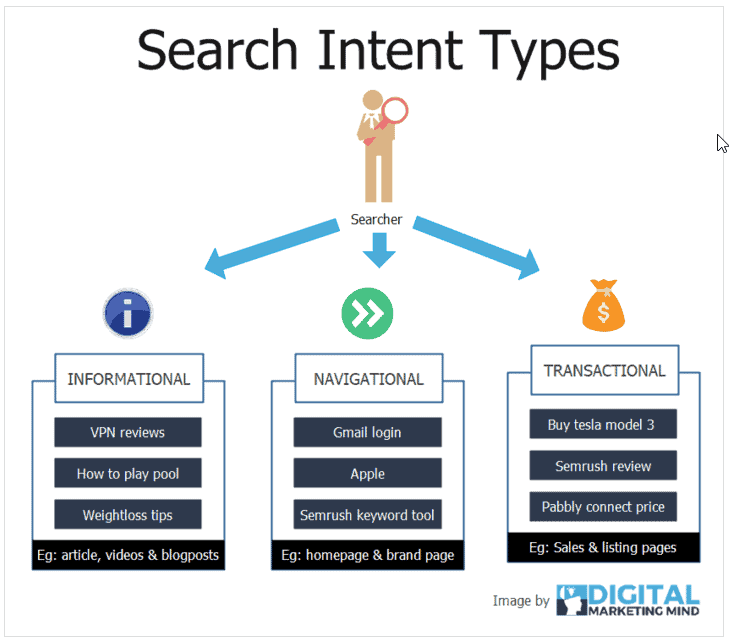
Informational keywords
In order to learn something new or useful from a topic, people use informational keywords – words they use to look for more information and to find out what they can about that topic.
Navigational keywords
People who use navigational keywords are looking for ways to accomplish their goals or considering ways to buy solutions.
Transactional/Commercial keywords
Keywords with a transactional or commercial intent are those used when someone wants to buy something.
Conclusion: Keyword Basics
This lesson introduced us to keyword types and types of keywords used in SEO.
Any SEO campaign must include keywords.
The whole process of SEO can fail if you do not know your keywords well enough, and you cannot guarantee that your site will rank for the right keywords.
We will learn more about searching for keywords and what makes a good keyword in the next lesson.
Good SEO Company VS Bad SEO Company in Sri Lanka
Search engine optimization is a term that is new to the business world. In fact many business owners do not understand SEO, what it entails, and the benefits it can provide.
Once a business owner has decided that SEO is a service that they need, they do not know how to go about finding a particular SEO company.
I don’t blame them. There are so many SEO companies that have sprung up over the past ten years that it is hard to decide which one to go with. This is especially true if you have little or no knowledge of how SEO works, and what the worth is.
There are a number of things that you should be looking for when you are considering hiring on an SEO company.
PROMISES
Bad SEO Company
If an SEO company tells you that they are going to guarantee you the number one spot for ranking, that should throw up some red flags – especially if their service is really cheap.
You can never guarantee someone the top spot for a particular set of keywords.
Another thing that you want to watch out for is link placement on sites with a good PR, being permanent.
A high percentage of links can never be guaranteed to be permanent, because usually the SEO doesn’t have any control over that.
Good SEO Company
A good SEO company tells you upfront that the top spot is something that you cannot guarantee them. They will let you know that they will do everything in their power as well as in your budget to rank you as high as possible through natural SEO strategies.
They will also let you know that this is something that takes time, and patience.
When you start talking about links, a good SEO company will tell you that they will give you a natural approach to link building based on quality content.
Promising links to be there forever is something that is not in the service. Instead they might offer link replacement, or a time frame in which links will stay live.
SERVICE PRICE
Bad SEO Company
A bad SEO company usually charges a low fixed rate, without detailing exactly what they are doing for you.
They do not give you any preference or diversity through packages, based on your preferences or budget. They just want to do the minimal amount of work for the littlest amount of effort.
The other thing that a Bad SEO company may do is charge an outrageous amount of money, to make it seem as though they have all the tools they need to be a good SEO company. Something they may offer is, 10,000 links, or 5,000 pages of optimized content.
Usually this means that they are a fly by night company, and even if they could produce those numbers, that would be considered over optimization – which you could be severely penalized for.
Good SEO Company
A good SEO company will offer a variety of SEO Services packages detailing the various types of work and services they will be providing.
This way you can work with the company to get consultation on the best strategic plan to give yourself an online presence.
A good SEO company will charge based on the amount of work provided, and what your needs may be.
There isn’t a one size fits all approach to SEO, so a variety of choices should always be offered.
ON-SITE SERVICE PROVIDED
Bad SEO Company
A bad SEO company usually never even mentions on-site SEO. This is typically because they don’t know anything about it.
You need to have strong on-site SEO to have a successful Internet marketing campaign.
Another thing a Bad SEO company may do is pass off a WordPress or Template theme as their own work. While there is nothing wrong with a template, you shouldn’t be charging for a template site like it is custom built.
Good SEO Company
A good SEO company will analyze your site from top to bottom using a few different tools. Most likely they will use SEO-Moz to diagnose your site page by page, using the campaign feature.
A good SEO company will also explain the difference between a WP and a custom design. They will break down the importance of keyword density, proper meta tags, header tags, title tags, and everything else that goes into on-site SEO.
They also will not overcharge you for doing these things, and many times give you honest advice for free.
IN THE END
Although this is just a few instances where you can tell the difference between a good and bad SEO company, they are some of the most important. Do a little bit of research and look for signs of bad practices when consulting with an SEO company.
Your best bet is to talk to a number of different professionals, that way you can find out the most information, and the most important information for your site.
A good SEO company won’t mind when you ask questions. In fact they will most likely encourage it.
Next Lesson: Keywords Guide
This is the next lesson we will learn keyword research.
Subscribe to our YouTube channel to stay updated.
https://www.youtube.com/c/alstonantony
Join our Group